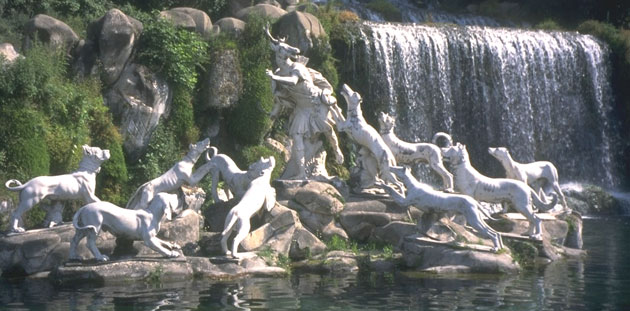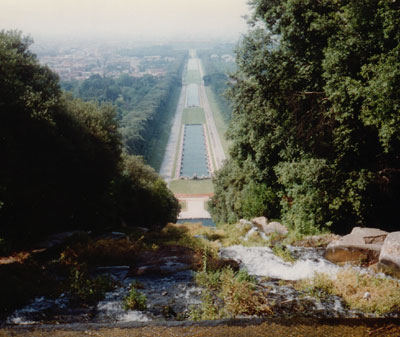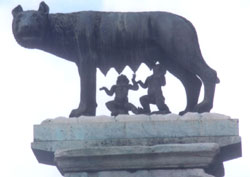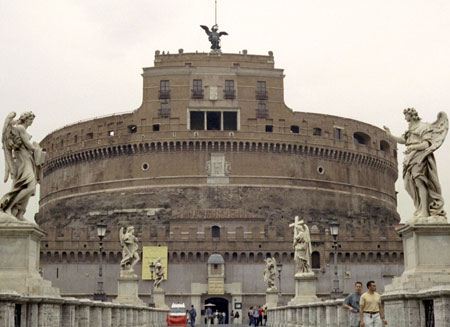Scene 9
|
|
| Contents | Donations | Feedback |
|
|
|
Scene 9 |
|
|
En route to Roma (Rome), we
swung by Caserta, a monstrous palace built for one of the Louis' of France
as an Italian version of Versailles. It almost defines obscene opulence
with room after room of 30' ceilings painted with Baroque portraits gilt
with gold, beautiful furnishings, marble statues, the works. The structure
itself is immense and houses not only its museum but thousands of government
offices as well. In back is a marvelous series of reflecting pools that
lead up to a waterfall, all adorned with statues telling the tale of Dianna,
who turned a hunter into a stag and set the hounds on him. No, I’m
not making this up for symbolic reasons, the stuff is really there. |
|
 |
| You can climb to the top of the falls and look back over the gardens, so large you can barely spot the palace in the distance. Napoli (Naples) isn't the place I'd have picked for a palace, but the city was once glorious. |  |
|
On to Roma, The Eternal City, Mother Rome. People have romanticized her for centuries, but what gets lost in the glamorization is the fact that it is a living, breathing, working city. Despite the layer upon layer upon layer of preserved history, attractions, museums, churches, ruins, and so on, the first thing you can't help but notice is the traffic. |
 |
|
|
|
|
Vespa Vermin are everywhere. They start training them as soon as they're
old enough to stand, sometimes sooner. I've seen a mother driving with her three-year-old
standing between her legs reaching up to grip the handlebars while his
brother of five clings to her back. They ride the machines so often
that they are an extension of their bodies and would sooner ride than
walk even the shortest distance. They never wear helmets and regularly
ignore street signals and signs. Add to this a healthy dose of apathetic
unsmiling pedestrians stepping from between cars parked so closely that
they often touch, the streets wall to wall with cars and the gaps filled
with Vespa Vermin and the rare gaps between those packed with pedestrians,
since often there’s no sidewalk, and you have the deadly recipe that
is urban Italian traffic. In 1999 the government finally required helmets for Vespa Vermin in Roma and the citizens were devastated. “It is the end of something beautiful” a citizen lamented. But a person was being killed at the rate of one per day – ONE PER DAY! And that’s just in Roma alone. Untold numbers of injuries and damage to vehicles, yet they had to be required to wear helmets. In Roma vehicles always yield to the pedestrians, even if they cross against the light and in the middle of the block. And they yield without yelling or cursing or even honking. (But step out in front of a car in Firenze and you’ll be lucky to get off with just obscene language. Heck, you’ll be lucky to get away with your life. Just one of those little differences to note.) In The Eternal City no matter how busy things are they aren't so bad that you can't cross the street. It's like an ant mound - you can't tell, but there is a system, an order of worker ants and army ants, chambers and passages, all hustle and bustle while the tourists try to worm their way through the passages to catch the sights. It's impossible to ignore - Roma is alive. |
|
Our hotel in Roma, Domus Pacis,
had a very poor reputation amongst the experienced members of our gang,
but I couldn’t figure out why. The place is clean and roomy compared
to Hotel Aequa. The only letdown was the lack of a pool. Aequa had spoiled
us on that one factor. Nothing could have been more desirable after a
day of tromping around Roma than a dip in a nice pool. But the only large
pools in Roma are fountains and you’re not allowed to play in those
beautiful creations.
|
|
| We walked down the street and stumbled into a book festival much like any artsy fest anywhere in the states. In fact, too much alike. Soon we were in search of something decidedly more Italiano, hopefully something with music, drinks and dancing. We wandered past Castel Sant Angelo, an impressive stack of bricks overlooking the Tever (Tiber River) and into another festival, this one with an 8000 lire admission fee. |
 Here's Castel Sant Angelo by day. The site was once a mausoleum for Hadrian. Then the Pope made it into a castle in which he could hide when the barbarians would come to town. There's still a walkway running all the way from the papal apartments in the Vatican up the street to the fortress. Now it houses a museum. |
| We were feeling adventurous so we shelled out the dough and wandered into what turned out to be a tacky expo laid out along the stone docks with people selling the same merchandise you'd find in any U.S. mall. The people-watching had enough entertainment value to make yours truly nearly nauseous with testosterone. Had we found the music and dancing for which we'd been searching, the accompanying hormones might have finished me off. I had images of that first night we went dancing together back in the States and wondered if I could take the pressure in our off-again status. But after hours of festival gawking we decided to head back to the hotel. | |
|